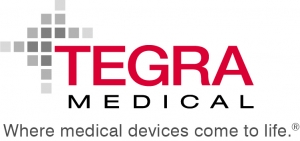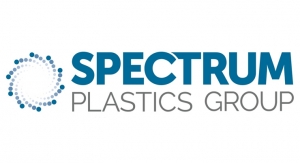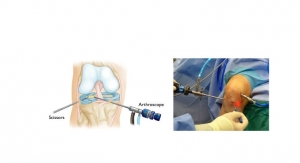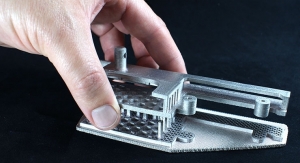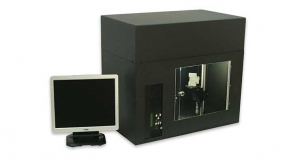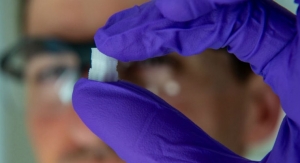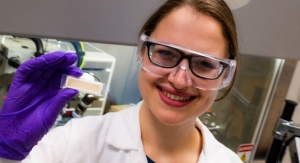Mark Crawford, Contributing Writer05.23.19
Orthopedic implants, as well as surgical instruments, are booming markets in the medical industry. Implant designs are becoming more complex and more effective in terms of ease of installation and patient outcomes, thanks to improvements in implant manufacturing processes. Hot markets include the extremities sector, especially foot and ankle, as well as spinal fusion and fixation devices. Additive manufacturing, both metal and plastic, continues to expand design options, improving implant functionality and complexity. Traditional machining methods also continue to improve, with better controls and higher precision.
“In the past, many design compromises were made due to the manufacturability limits for specific geometric features, materials, and surface finishes,” said Bob Tarantino, president of New Jersey Precision Technologies, a Mountainside, N.J.-based manufacturer of medical devices for a variety of applications, including surgical instruments and implants. “Recently, an accelerated pace of design improvement has been driven by improved machining processes in many areas including sinker electrical discharge machining [EDM], wire EDM, five-axis computer numerical control milling, and additive manufacturing with improved post-additive finishing.”
OEMs leverage traditional methods whenever they can, such as casting, forging, and machining, for parts that do not require the unique structures, or part geometries made possible only by additive manufacturing. Depending on the project, traditional methods can also be combined with additive manufacturing (AM) to provide the best solution for a challenging design.
“For example, advanced robotic machining, coupled with additive manufacturing capabilities, allows us to offer robust solutions to the medical device industry’s most complex problems,” said Micah Di Sabato, manager of business development for Slice Manufacturing Studios, an Akron, Ohio-based contract manufacturer that provides a comprehensive suite of services to medical OEMs, including advanced machining, prototyping, and metal/plastic additive manufacturing.
Medical device manufacturers (MDMs) increasingly outsource implant design and manufacturing to trusted contract manufacturers, counting on their expertise to design the best possible device, at the best price point, that adds value to the end-user experience and improves patient outcomes.
What OEMs Want
OEMs are clear about what they want from their contract manufacturers—design for manufacturability, quality, regulatory compliance, price, and delivery (lead time). As competition increases, perhaps the most important service a contract manufacturer (CM) can provide is meeting customer lead times, which continue to contract. Speed to market and meeting production schedules and deadlines are crucial for survival. Because OEMs are also trending toward “just-in-time” delivery, CMs must be quick, responsive, and have the resources necessary to meet these challenging time constraints.
“If a surgical procedure is scheduled and the OEM has parts on back order, that creates a bad situation,” said Mark Johnson, key account manager for Minneapolis, Minn.-based Spectrum Plastics Group’s Specialty Molding Division, which specializes in custom plastic injection molding of highly engineered thermoplastic resins.
“OEMs are always looking for vertically integrated contract manufacturers with mature quality management systems and deep experience in regulatory practices to improve their lead times,” said Raghu Vadlamudi, chief research and technology director for Donatelle, a New Brighton, Minn.-based manufacturer of medical devices.
“The industry routinely tells us that most contract manufacturers provide minimal to zero communication throughout the manufacturing process,” added Di Sabato. “We streamline communication and the supply chain by offering many different services in one location—literally enabling us to take a concept to commercialization.”
Once under way, OEMs expect open and honest communication, streamlined supply chain operation, and shortened lead times.
“OEMs want clarity on our expectations, as well as the expectations of our customers, who are surgeons,” said Todd Andreoni, director of advanced operations for the spine division of Stryker, a Leesburg, Va.-based manufacturer of medical devices, including those for orthopedics, surgery, neurotechnology, and spine. “In particular, they want clarity on buy specifications or user requirement specifications.”
OEMs want to be informed about any issues that arise, and how they are being addressed. This builds trust, which improves confidence in decision-making and shortens time to market. End results are always the most successful when teamwork starts in the earliest stages of design and continues through manufacturing and delivery. When this can be achieved, time to launch for existing parts can be as short as four to six weeks and about six months or less for newly developed products.
Current Orthopedic Trends
Implants are being made using advanced methods of both additive and subtractive technologies, including multi-axis multi-spindle turning and automated coating and cleaning. Metal additive manufacturing for production is on the rise using several methods, including laser and electron beam (EBM) 3D printing modalities. EBM allows significant design flexibility and can replicate the look of current or legacy machined products, while adding trabecular structures just as easily as it can create an entire new product family.
“We are seeing significant demand increases in metal additive manufacturing and new applications for its use,” said Di Sabato. “Working with a partner that understands how things like design structure and build placement affect strength, effectiveness, and functionality is increasingly important. As companies gain more expertise with FDA clearance of metal additively manufactured products, we fully expect it to expand in nearly every level of manufacturing of the industry.”
Metal-based implants are still dominated by titanium. Many titanium implant components for spine, knee, and hip are now being designed for specific manufacturing processes. For example, features that were once impractical to machine can now be produced economically and routinely using new wire EDM machines with improved angle cutting capabilities and higher accuracy. Implants can now be designed with wire-cut features of up to 45 degrees using four-axis angle cutting, without requiring any special workpiece tilting fixtures. “This was not practical or possible for wire EDM just a few years ago,” said Tarantino.
In addition, he noted, many of the higher tolerances and surface finishes specified are now easily achieved due to improved EDM power supply technology and machine feedback system improvements. This allows for better implant quality for many spine implant assemblies used to treat patients with degenerative disc disease. With these improved wire EDM accuracies and surface finishes, “today’s spine implants allow surgeons to adjust the device between the two vertebrae without binding and with a smoothness that can be felt when it is in the correct position,” said Tarantino.
More additively manufactured spinal cage implants are coming into the market. The substrate for the biocompatible titanium allows for complex geometries, such as lattice patterns. “This enables the device to be less stiff and to have a microporous surface texture that promotes bone growth,” said Randy Sible, general manager for the Hernando, Miss., location of Tegra Medical, a Franklin, Mass.-based manufacturer of medical devices and complex components. “It’s a developing technology and, for some devices, machining is still needed to finalize these products. Their intricate shapes and nearly porous surfaces can present a challenge to manufacturers; we have, however, developed a unique machining process that efficiently produces these devices.”
Stryker relies on its own “AMagine” technology to additively manufacture spinal implants. This process produces randomized yet reproducible porous structures that are difficult or impossible to create using traditional manufacturing techniques. AMagine allows Stryker to create Tritanium—a novel, highly porous titanium material designed for bone in-growth and biological fixation. Its porous structure is designed with fully interconnected porosity, and although it has an organic and randomized appearance, this effect is entirely controlled through a computer model. The properties of the porous matrix are engineered to be consistent throughout the structure.
Demand is also growing for non-traditional alternatives to metal-based implants. This includes high-strength textiles-based-solutions, especially for applications in load-bearing sports medicine and spinal indications. The number of applications for implantable textiles continues to expand, thanks to advances in new materials and the need for more “active” devices such as drug/device combination products. One of the greatest benefits of implantable textile devices is that they can be patient-specific and developed for specialized end-user needs.
The availability of both variable geometry textiles processing and stronger resorbable polymer implants is inspiring innovative implant designs. For example, higher-strength materials enable the introduction of increased porosity to implant design, which improves osteo-conductivity and patient outcomes. Improvements in textiles manufacturing—across weaving, braiding, and knitting—are made possible by advanced, digitally controlled, variable output textile manufacturing equipment.
“This diversity within a product design enables OEMs to tailor implantable device geometry in line with preferred device function in-vivo,” said Eoghan Groonell, marketing executive for Aran Biomedical, a Galway, Ireland-based provider of implantable device development and manufacturing services. “For example, variable pore size repair scaffolds enable differential tissue response, while variable diameter sutures enable smarter instrumentation solutions. Increased adoption of early intervention procedures and products, coupled with the uptake in minimally invasive surgical methods, means that low-profile textiles-based and resorbable-biomaterial-based products are of relevance for many new product introductions.”
Technology Improvements
Advances in AM have reduced lead times for prototyping and small-volume production of highly complex parts from months to weeks. AM offers design freedom and the capability to build products that cannot be built using conventional subtractive manufacturing. The flexibility of AM also allows production of multiple size variants of any design.
“As a contract manufacturer, we see a strong demand for custom trabecular structures that promote bone ingrowth in hip, knee, shoulder, and ankle arthroplasty devices as well as spinal implants,” said Di Sabato. “These porous structures can be made only with additive manufacturing but create unique challenges as it relates to cleaning and biocompatibility.”
Additive manufacturing also facilitates weight reduction and simplicity in instrument design. With the growing trend of surgeons performing orthopedic procedures in the outpatient setting, there is enhanced focus on simplifying the procedure and also minimizing burden on the surgical center’s sterile processing department. “Certain OEMs have re-thought how to deliver instrumentation and now provide everything that is needed in a surgery in just two trays, instead of the traditional five to seven,” said Di Sabato. “Creative engineering, and improvements in 3D technology and high-strength/low-weight materials, have made this possible. For example, one of our customers has reduced instrumentation trays from a weight of 25 pounds to just 10 pounds.”
New technologies such as robotic-arm-assisted surgery, virtual reality/augmented reality (VR/AR), and other innovations can unlock new ways to consider implant design. Limitations on innovative thinking become less restrictive with each new advancement.
“When surgery requires an implant, we are often removing bone and replacing it with an implant that does not resemble the excised bone,” said Andreoni. “That’s because our cutting tools are predominantly straight saw blades, drills, or reamers milling along a fixed axis. With robotic-arm-assisted surgery, our cutting tools will change, because we will be able to prepare the bone for an implant by cutting on any number of axes. Future implant geometries may no longer resemble the profiles of today’s cutting tools and may begin resembling organic shapes of the excised bone. This will hopefully lead to a reduction of the amount of native bone removal during surgery and other patient benefits.”
Advanced Materials
Popular materials for implants today include Ti-6Al-4V, 316L, cobalt chromium, ultra-high molecular weight polyethylene (UHMWPE), polyetheretherketone (PEEK), and zirconium. Coating technologies are also emerging that have the potential to enhance osseointegration and prevent infection.
Thanks to their widely known properties of biocompatibility, high strength-to-weight ratio, and corrosion resistance, titanium and titanium alloys represent the largest share of the orthopedic implant market. PEEK, however, is still a popular material choice for cages used in lumbar interbody fusion procedures. More material manufacturers are now offering implantable grades of PEEK. Application methods, such as vacuum-plasma-spraying, can coat a PEEK substrate with a porous layer of titanium to enhance bone growth.
PEEK is also being used for much smaller parts—for example, Donatelle recently produced a part made from PEEK that weighs 0.0001 grams, with a wall thickness of 38 microns. Other materials, such as acrylic, are being tested for biocompatibility for use as implantable materials. Acrylics are of interest because of their reduced cost, transparency, and ease of processing.
Another positive PEEK development is that CMs can now purchase PEEK directly, instead of going through their OEM partners. In the past, due to supplier restrictions, OEMs were required to purchase the material on behalf of their contract manufacturers. This created extra paperwork, increased financial burden on the OEM, and slowed down the manufacturing process. “The ability to purchase PEEK directly for our customers’ projects simplifies our relationships and allows us to service them better,” said Sible. “It’s great news for OEMs.”
In the coatings world, suppliers are focused on antimicrobial coatings and texture-producing coatings that improve wear resistance and osseointegration. Titanium surfaces are typically sprayed with calcium phosphate/hydroxyapatite-based coatings to promote bone growth. A key concern among implant manufacturers is minimizing the risk of bacterial infection in implant patients. Although textured surfaces aid bone growth, the roughness of the surface can also attract bacteria. A surface roughness in the nanometer range seems to create the best tradeoff between enhancing bone growth and reducing the risk for bacterial infections.
Medical researchers at McMaster University in Hamilton, Ontario, Canada, have nano-engineered a new surface coating that can be tuned to repel bacteria, viruses, or living cells. If commercialized, these coatings may help certain implants, such as vascular grafts, replacement heart valves, and artificial joints, integrate with human tissue and bone without the risk of infection or blood clotting. Such surfaces may also have the potential to reduce the frequency of false positives and negatives in medical tests by eliminating interference from non-target elements in blood and urine.
Regulatory Challenges
Although OEMs want to adopt new materials and technologies, they are wary of the added time and cost of testing needed to meet the requirements of the FDA and other regulatory bodies. The FDA is, in general, highly conservative regarding new manufacturing technologies and continues to impose rigorous demands on OEMs to prove that implantable devices manufactured with 3D printing, for example, are clean, biocompatible, and safe.
Regulatory agencies around the world desire a deeper understanding of additive manufacturing processes and how they might impact human health. In December 2017, the FDA issued a guidance entitled “Technical Considerations for Additive Manufactured Medical Devices.” Other agencies have issued (or plan to issue) similar documents. To help regulators understand the benefits of AM technologies, MDMs can be proactive and share their processes and design controls with the FDA. “We are excited to share the story of our AMagine technology with regulatory agencies,” said John Rossman, associate manager of regulatory affairs for Stryker. “For example, we recently participated in an FDA vendor day for additive manufacturing and have also presented to other working groups to show that additive-manufactured products can be safe and effective and dramatically improve patient outcomes.”
OEMs expect heightened scrutiny from regulatory agencies for material selection, especially for long-term implants. Risk/benefit analyses and biocompatibility evaluations are completed pre-market to demonstrate potential adverse biological response and whether associated risks are acceptable. While testing typically addresses localized responses, long-term systemic effects also must be considered in long-term implants including metal, breast implants, and animal materials.
“FDA commissioner Scott Gottlieb and Center for Devices and Radiological Health (CDRH) director Jeff Shuren recently published a statement describing FDA’s efforts to evaluate materials in medical devices,” said Jodi Raus, senior director for global clinical and regulatory for DSM Biomedical. “A white paper will be published this fall and an advisory panel meeting planned to help the FDA determine what scientific information they should solicit from manufacturers.”
Moving Forward
Regulatory requirements associated with cleaning, biocompatibility, sterilization, process validations, and risk management will continue to evolve for implant manufacturers. Adoption of a growing variety of minimally invasive procedures, as well as better refinement in the spinal surgical robots and navigation systems, will drive growth of the implant manufacturing market.
Additive manufacturing continues to develop at a rapid pace, both in terms of technologies and materials. For example, researchers at Rice University have developed a technique to grow live bone to repair craniofacial injuries by attaching a 3D-printed bioreactor (a mold) to a rib. Stem cells and blood vessels from the rib infiltrate scaffold material in the mold and replace it with natural bone custom-fit to the patient. This process has the potential to eliminate the painful process of harvesting bone grafts from different areas of the patient. “We are leveraging a 3D-printed bioreactor to form bone grown in another part of the body, while we prime the defect to accept the newly generated tissue,” said Antonios Mikos, a professor of bioengineering and biomolecular engineering at Rice University and a member of the research team.
In another announcement, researchers at the German Fraunhofer Institute have designed a new technique for 3D printing bone implants. A cold plasma jet is injected between each layer of copolymer, which then makes it possible to add antibiotics into the implant structure, promoting natural cell growth inside and outside the implant.
Andreoni is amazed by the speed at which product design and manufacturing processes are becoming digitized, analyzed, and connected to enhance product quality, reduce costs, and shorten lead times.
“I am encouraged to see the many ways manufacturers are utilizing connectivity metadata to make informed decisions, ranging from analytics to the supply chain to manufacturing to shortening production times,” he said. “Increasingly, our surgeon customers expect more product features, in less time, than ever before—digitalized manufacturing will help implant manufacturers deliver on these expectations.”
Mark Crawford is a full-time freelance business and marketing/communications writer based in Madison, Wis. His clients range from startups to global manufacturing leaders. He also writes a variety of feature articles for regional and national publications and is the author of five books.
“In the past, many design compromises were made due to the manufacturability limits for specific geometric features, materials, and surface finishes,” said Bob Tarantino, president of New Jersey Precision Technologies, a Mountainside, N.J.-based manufacturer of medical devices for a variety of applications, including surgical instruments and implants. “Recently, an accelerated pace of design improvement has been driven by improved machining processes in many areas including sinker electrical discharge machining [EDM], wire EDM, five-axis computer numerical control milling, and additive manufacturing with improved post-additive finishing.”
OEMs leverage traditional methods whenever they can, such as casting, forging, and machining, for parts that do not require the unique structures, or part geometries made possible only by additive manufacturing. Depending on the project, traditional methods can also be combined with additive manufacturing (AM) to provide the best solution for a challenging design.
“For example, advanced robotic machining, coupled with additive manufacturing capabilities, allows us to offer robust solutions to the medical device industry’s most complex problems,” said Micah Di Sabato, manager of business development for Slice Manufacturing Studios, an Akron, Ohio-based contract manufacturer that provides a comprehensive suite of services to medical OEMs, including advanced machining, prototyping, and metal/plastic additive manufacturing.
Medical device manufacturers (MDMs) increasingly outsource implant design and manufacturing to trusted contract manufacturers, counting on their expertise to design the best possible device, at the best price point, that adds value to the end-user experience and improves patient outcomes.
What OEMs Want
OEMs are clear about what they want from their contract manufacturers—design for manufacturability, quality, regulatory compliance, price, and delivery (lead time). As competition increases, perhaps the most important service a contract manufacturer (CM) can provide is meeting customer lead times, which continue to contract. Speed to market and meeting production schedules and deadlines are crucial for survival. Because OEMs are also trending toward “just-in-time” delivery, CMs must be quick, responsive, and have the resources necessary to meet these challenging time constraints.
“If a surgical procedure is scheduled and the OEM has parts on back order, that creates a bad situation,” said Mark Johnson, key account manager for Minneapolis, Minn.-based Spectrum Plastics Group’s Specialty Molding Division, which specializes in custom plastic injection molding of highly engineered thermoplastic resins.
“OEMs are always looking for vertically integrated contract manufacturers with mature quality management systems and deep experience in regulatory practices to improve their lead times,” said Raghu Vadlamudi, chief research and technology director for Donatelle, a New Brighton, Minn.-based manufacturer of medical devices.
“The industry routinely tells us that most contract manufacturers provide minimal to zero communication throughout the manufacturing process,” added Di Sabato. “We streamline communication and the supply chain by offering many different services in one location—literally enabling us to take a concept to commercialization.”
Once under way, OEMs expect open and honest communication, streamlined supply chain operation, and shortened lead times.
“OEMs want clarity on our expectations, as well as the expectations of our customers, who are surgeons,” said Todd Andreoni, director of advanced operations for the spine division of Stryker, a Leesburg, Va.-based manufacturer of medical devices, including those for orthopedics, surgery, neurotechnology, and spine. “In particular, they want clarity on buy specifications or user requirement specifications.”
OEMs want to be informed about any issues that arise, and how they are being addressed. This builds trust, which improves confidence in decision-making and shortens time to market. End results are always the most successful when teamwork starts in the earliest stages of design and continues through manufacturing and delivery. When this can be achieved, time to launch for existing parts can be as short as four to six weeks and about six months or less for newly developed products.
Current Orthopedic Trends
Implants are being made using advanced methods of both additive and subtractive technologies, including multi-axis multi-spindle turning and automated coating and cleaning. Metal additive manufacturing for production is on the rise using several methods, including laser and electron beam (EBM) 3D printing modalities. EBM allows significant design flexibility and can replicate the look of current or legacy machined products, while adding trabecular structures just as easily as it can create an entire new product family.
“We are seeing significant demand increases in metal additive manufacturing and new applications for its use,” said Di Sabato. “Working with a partner that understands how things like design structure and build placement affect strength, effectiveness, and functionality is increasingly important. As companies gain more expertise with FDA clearance of metal additively manufactured products, we fully expect it to expand in nearly every level of manufacturing of the industry.”
Metal-based implants are still dominated by titanium. Many titanium implant components for spine, knee, and hip are now being designed for specific manufacturing processes. For example, features that were once impractical to machine can now be produced economically and routinely using new wire EDM machines with improved angle cutting capabilities and higher accuracy. Implants can now be designed with wire-cut features of up to 45 degrees using four-axis angle cutting, without requiring any special workpiece tilting fixtures. “This was not practical or possible for wire EDM just a few years ago,” said Tarantino.
In addition, he noted, many of the higher tolerances and surface finishes specified are now easily achieved due to improved EDM power supply technology and machine feedback system improvements. This allows for better implant quality for many spine implant assemblies used to treat patients with degenerative disc disease. With these improved wire EDM accuracies and surface finishes, “today’s spine implants allow surgeons to adjust the device between the two vertebrae without binding and with a smoothness that can be felt when it is in the correct position,” said Tarantino.
More additively manufactured spinal cage implants are coming into the market. The substrate for the biocompatible titanium allows for complex geometries, such as lattice patterns. “This enables the device to be less stiff and to have a microporous surface texture that promotes bone growth,” said Randy Sible, general manager for the Hernando, Miss., location of Tegra Medical, a Franklin, Mass.-based manufacturer of medical devices and complex components. “It’s a developing technology and, for some devices, machining is still needed to finalize these products. Their intricate shapes and nearly porous surfaces can present a challenge to manufacturers; we have, however, developed a unique machining process that efficiently produces these devices.”
Stryker relies on its own “AMagine” technology to additively manufacture spinal implants. This process produces randomized yet reproducible porous structures that are difficult or impossible to create using traditional manufacturing techniques. AMagine allows Stryker to create Tritanium—a novel, highly porous titanium material designed for bone in-growth and biological fixation. Its porous structure is designed with fully interconnected porosity, and although it has an organic and randomized appearance, this effect is entirely controlled through a computer model. The properties of the porous matrix are engineered to be consistent throughout the structure.
Demand is also growing for non-traditional alternatives to metal-based implants. This includes high-strength textiles-based-solutions, especially for applications in load-bearing sports medicine and spinal indications. The number of applications for implantable textiles continues to expand, thanks to advances in new materials and the need for more “active” devices such as drug/device combination products. One of the greatest benefits of implantable textile devices is that they can be patient-specific and developed for specialized end-user needs.
The availability of both variable geometry textiles processing and stronger resorbable polymer implants is inspiring innovative implant designs. For example, higher-strength materials enable the introduction of increased porosity to implant design, which improves osteo-conductivity and patient outcomes. Improvements in textiles manufacturing—across weaving, braiding, and knitting—are made possible by advanced, digitally controlled, variable output textile manufacturing equipment.
“This diversity within a product design enables OEMs to tailor implantable device geometry in line with preferred device function in-vivo,” said Eoghan Groonell, marketing executive for Aran Biomedical, a Galway, Ireland-based provider of implantable device development and manufacturing services. “For example, variable pore size repair scaffolds enable differential tissue response, while variable diameter sutures enable smarter instrumentation solutions. Increased adoption of early intervention procedures and products, coupled with the uptake in minimally invasive surgical methods, means that low-profile textiles-based and resorbable-biomaterial-based products are of relevance for many new product introductions.”
Technology Improvements
Advances in AM have reduced lead times for prototyping and small-volume production of highly complex parts from months to weeks. AM offers design freedom and the capability to build products that cannot be built using conventional subtractive manufacturing. The flexibility of AM also allows production of multiple size variants of any design.
“As a contract manufacturer, we see a strong demand for custom trabecular structures that promote bone ingrowth in hip, knee, shoulder, and ankle arthroplasty devices as well as spinal implants,” said Di Sabato. “These porous structures can be made only with additive manufacturing but create unique challenges as it relates to cleaning and biocompatibility.”
Additive manufacturing also facilitates weight reduction and simplicity in instrument design. With the growing trend of surgeons performing orthopedic procedures in the outpatient setting, there is enhanced focus on simplifying the procedure and also minimizing burden on the surgical center’s sterile processing department. “Certain OEMs have re-thought how to deliver instrumentation and now provide everything that is needed in a surgery in just two trays, instead of the traditional five to seven,” said Di Sabato. “Creative engineering, and improvements in 3D technology and high-strength/low-weight materials, have made this possible. For example, one of our customers has reduced instrumentation trays from a weight of 25 pounds to just 10 pounds.”
New technologies such as robotic-arm-assisted surgery, virtual reality/augmented reality (VR/AR), and other innovations can unlock new ways to consider implant design. Limitations on innovative thinking become less restrictive with each new advancement.
“When surgery requires an implant, we are often removing bone and replacing it with an implant that does not resemble the excised bone,” said Andreoni. “That’s because our cutting tools are predominantly straight saw blades, drills, or reamers milling along a fixed axis. With robotic-arm-assisted surgery, our cutting tools will change, because we will be able to prepare the bone for an implant by cutting on any number of axes. Future implant geometries may no longer resemble the profiles of today’s cutting tools and may begin resembling organic shapes of the excised bone. This will hopefully lead to a reduction of the amount of native bone removal during surgery and other patient benefits.”
Advanced Materials
Popular materials for implants today include Ti-6Al-4V, 316L, cobalt chromium, ultra-high molecular weight polyethylene (UHMWPE), polyetheretherketone (PEEK), and zirconium. Coating technologies are also emerging that have the potential to enhance osseointegration and prevent infection.
Thanks to their widely known properties of biocompatibility, high strength-to-weight ratio, and corrosion resistance, titanium and titanium alloys represent the largest share of the orthopedic implant market. PEEK, however, is still a popular material choice for cages used in lumbar interbody fusion procedures. More material manufacturers are now offering implantable grades of PEEK. Application methods, such as vacuum-plasma-spraying, can coat a PEEK substrate with a porous layer of titanium to enhance bone growth.
PEEK is also being used for much smaller parts—for example, Donatelle recently produced a part made from PEEK that weighs 0.0001 grams, with a wall thickness of 38 microns. Other materials, such as acrylic, are being tested for biocompatibility for use as implantable materials. Acrylics are of interest because of their reduced cost, transparency, and ease of processing.
Another positive PEEK development is that CMs can now purchase PEEK directly, instead of going through their OEM partners. In the past, due to supplier restrictions, OEMs were required to purchase the material on behalf of their contract manufacturers. This created extra paperwork, increased financial burden on the OEM, and slowed down the manufacturing process. “The ability to purchase PEEK directly for our customers’ projects simplifies our relationships and allows us to service them better,” said Sible. “It’s great news for OEMs.”
In the coatings world, suppliers are focused on antimicrobial coatings and texture-producing coatings that improve wear resistance and osseointegration. Titanium surfaces are typically sprayed with calcium phosphate/hydroxyapatite-based coatings to promote bone growth. A key concern among implant manufacturers is minimizing the risk of bacterial infection in implant patients. Although textured surfaces aid bone growth, the roughness of the surface can also attract bacteria. A surface roughness in the nanometer range seems to create the best tradeoff between enhancing bone growth and reducing the risk for bacterial infections.
Medical researchers at McMaster University in Hamilton, Ontario, Canada, have nano-engineered a new surface coating that can be tuned to repel bacteria, viruses, or living cells. If commercialized, these coatings may help certain implants, such as vascular grafts, replacement heart valves, and artificial joints, integrate with human tissue and bone without the risk of infection or blood clotting. Such surfaces may also have the potential to reduce the frequency of false positives and negatives in medical tests by eliminating interference from non-target elements in blood and urine.
Regulatory Challenges
Although OEMs want to adopt new materials and technologies, they are wary of the added time and cost of testing needed to meet the requirements of the FDA and other regulatory bodies. The FDA is, in general, highly conservative regarding new manufacturing technologies and continues to impose rigorous demands on OEMs to prove that implantable devices manufactured with 3D printing, for example, are clean, biocompatible, and safe.
Regulatory agencies around the world desire a deeper understanding of additive manufacturing processes and how they might impact human health. In December 2017, the FDA issued a guidance entitled “Technical Considerations for Additive Manufactured Medical Devices.” Other agencies have issued (or plan to issue) similar documents. To help regulators understand the benefits of AM technologies, MDMs can be proactive and share their processes and design controls with the FDA. “We are excited to share the story of our AMagine technology with regulatory agencies,” said John Rossman, associate manager of regulatory affairs for Stryker. “For example, we recently participated in an FDA vendor day for additive manufacturing and have also presented to other working groups to show that additive-manufactured products can be safe and effective and dramatically improve patient outcomes.”
OEMs expect heightened scrutiny from regulatory agencies for material selection, especially for long-term implants. Risk/benefit analyses and biocompatibility evaluations are completed pre-market to demonstrate potential adverse biological response and whether associated risks are acceptable. While testing typically addresses localized responses, long-term systemic effects also must be considered in long-term implants including metal, breast implants, and animal materials.
“FDA commissioner Scott Gottlieb and Center for Devices and Radiological Health (CDRH) director Jeff Shuren recently published a statement describing FDA’s efforts to evaluate materials in medical devices,” said Jodi Raus, senior director for global clinical and regulatory for DSM Biomedical. “A white paper will be published this fall and an advisory panel meeting planned to help the FDA determine what scientific information they should solicit from manufacturers.”
Moving Forward
Regulatory requirements associated with cleaning, biocompatibility, sterilization, process validations, and risk management will continue to evolve for implant manufacturers. Adoption of a growing variety of minimally invasive procedures, as well as better refinement in the spinal surgical robots and navigation systems, will drive growth of the implant manufacturing market.
Additive manufacturing continues to develop at a rapid pace, both in terms of technologies and materials. For example, researchers at Rice University have developed a technique to grow live bone to repair craniofacial injuries by attaching a 3D-printed bioreactor (a mold) to a rib. Stem cells and blood vessels from the rib infiltrate scaffold material in the mold and replace it with natural bone custom-fit to the patient. This process has the potential to eliminate the painful process of harvesting bone grafts from different areas of the patient. “We are leveraging a 3D-printed bioreactor to form bone grown in another part of the body, while we prime the defect to accept the newly generated tissue,” said Antonios Mikos, a professor of bioengineering and biomolecular engineering at Rice University and a member of the research team.
In another announcement, researchers at the German Fraunhofer Institute have designed a new technique for 3D printing bone implants. A cold plasma jet is injected between each layer of copolymer, which then makes it possible to add antibiotics into the implant structure, promoting natural cell growth inside and outside the implant.
Andreoni is amazed by the speed at which product design and manufacturing processes are becoming digitized, analyzed, and connected to enhance product quality, reduce costs, and shorten lead times.
“I am encouraged to see the many ways manufacturers are utilizing connectivity metadata to make informed decisions, ranging from analytics to the supply chain to manufacturing to shortening production times,” he said. “Increasingly, our surgeon customers expect more product features, in less time, than ever before—digitalized manufacturing will help implant manufacturers deliver on these expectations.”
Mark Crawford is a full-time freelance business and marketing/communications writer based in Madison, Wis. His clients range from startups to global manufacturing leaders. He also writes a variety of feature articles for regional and national publications and is the author of five books.




